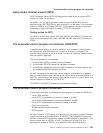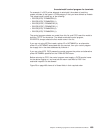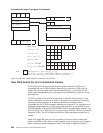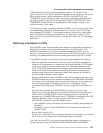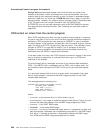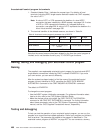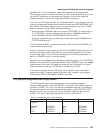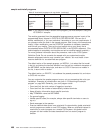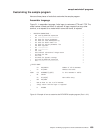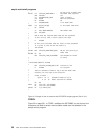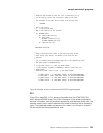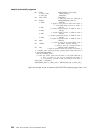
A suggested course of action is as follows:
1. Determine whether a model such as ‘mmmmmmmm’ is suitable. If there are
several models that have identical BIND images, differing only in end-user
options, then only the first such model is named in the above message. It will
be up to your control program to make the choice, when the logmode table
entry is corrected.
2. Identify the VTAM logmode table entry that is being used.
3. Check that this logmode table entry is not successfully in use with other
applications, so that to change it might cause this other use of it to fail.
4. Amend the logmode table entry by switching the bits corresponding to 1-bits in
the mismatch string. That is, if the bit in the VTAM BIND image corresponding to
the bit position set to ‘1’ in ‘xxxxxxxx...’ above is ‘1’, set it to ‘0’; if it is ‘0’, set it
to ‘1’.
More information about the meaning of the bits in a BIND image, and some more
references, may be found in
ACF/VTAM Version 3 Programming
.
The autoinstall control program at DELETE
To provide symmetry of control over the autoinstall process, the autoinstall control
program is also invoked when:
v A session with a previously automatically-installed resource has been ended
v An autoinstall request was accepted by the user program, but the subsequent
INSTALL process failed for some reason.
To make it easier for you to write your control program, these two events can be
considered to be identical. (There is no difference in the environment that exists, or
in the actions that might need to be performed.)
Invoking the control program at DELETE enables you to reverse the processes
carried out at the INSTALL event. For example, if the control program at INSTALL
incremented a count of the total number of automatically installed resources, then
the control program at DELETE would decrement that count.
The communication area at DELETE for terminals
Input to the program is via a communication area, addressed by DFHEICAP. The
layout of the communication area is shown in Figure 30.
The parameter list contains the following information:
Fullword 1 Standard Header
Byte 1 Function Code (X'F1')
Bytes2-3 Component Code Always "ZC"
Byte 4 Reserved Always X'00'
Fullword 2 Terminal ID of terminal to be deleted
Fullword 3 NETNAME of terminal to be deleted
Bytes 1-2 Delete netname length
Bytes 3-4 Start of Delete netname ID
Next 15 bytes Remainder of Delete netname ID
Figure 30. Autoinstall control program’s communication area at DELETE. For terminals
(including APPC single-session devices).
the autoinstall control program for terminals
Chapter 10. Writing a program to control autoinstall of terminals 495



